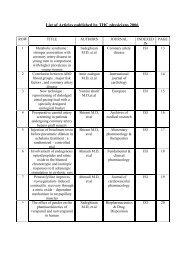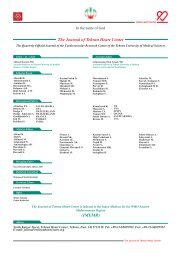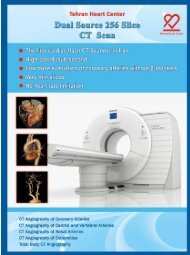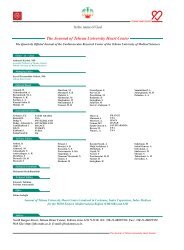Post coronary artery bypass graft surgery
Post coronary artery bypass graft surgery
Post coronary artery bypass graft surgery
You also want an ePaper? Increase the reach of your titles
YUMPU automatically turns print PDFs into web optimized ePapers that Google loves.
Carotid stenting in candidates for <strong>coronary</strong> <strong>artery</strong> <strong>bypass</strong><br />
<strong>surgery</strong>: results of a heart hospital registry<br />
Kassaian SE, Kazemisaleh D, Alidoosti M, Salarifar M, Haji Zeinali AM, Hakki<br />
E, Sahraian AM, Gheini MR and Abbasi SH<br />
Abstract<br />
Background: In patients with severe coexisting <strong>coronary</strong> and carotid <strong>artery</strong> disease, 2<br />
treatment strategies may be used: simultaneous endarterectomy and <strong>coronary</strong> <strong>bypass</strong><br />
<strong>surgery</strong> or carotid stenting with delayed <strong>coronary</strong> <strong>bypass</strong> <strong>surgery</strong> after a few weeks. We<br />
sought to evaluate the safety and efficacy of carotid stenting with delayed <strong>coronary</strong><br />
<strong>bypass</strong> <strong>surgery</strong> after a few weeks in patients of Tehran Heart Center. Based on<br />
observations made in this study and previous lesion typing studies, we aimed to<br />
determine predictors that may be used to select the appropriate treatment plan for such<br />
patients.<br />
Methods: Between December 2003 and October 2004, thirty consecutive patients<br />
underwent carotid stenting. The mean age of the patients was 66.3 ± 8 years. All of the<br />
patients had significant <strong>coronary</strong> <strong>artery</strong> disease. Symptomatic patients with>60% stenosis<br />
and symptomatic patients with> 80% stenosis were included. A complete neurological<br />
history was taken and an examination performed on all patients by an experienced<br />
neourologist. The study protocol required that an independent neourologist not involved<br />
in the interventional procedure evaluate parients using the National Institute of Health<br />
Stroke Scale before the procedure and then 24 hours, 1 month, and 6 months after the<br />
procedure. Carotid duplex (based on the Washington criteria), magnetic resonance<br />
imaging, or computed tomographyof the head and complete diagnostic angiography,<br />
including intracranial views and assessment of the collateral circulation, were performed<br />
on all patients. Stenoses were crossed with a 0.014inch filter wire, which was placed at<br />
the site of internal carotid <strong>artery</strong> distal to the lesion. In most cases, predilation (low<br />
profile 3.5-4mm <strong>coronary</strong> balloon and low pressure) was performed before stent<br />
placement. Ballon inflations were routinely performed within the stents after placement.<br />
Continuous intravenous heparin was given during the night, and vascular sheats were<br />
removed the morning after the procedure. The clinical endpoints were major or minor<br />
stroke myocardial infarction, or death during follow up period.<br />
Results: The procedural success rate was 96.66%. For a mean follow up period of 5.6 ±<br />
3.2 months, 4 deaths occurred (17% of cases), none of which were attributed to a<br />
neurologic cause. Also 1(3%) case had a minor non fatal stroke (transient cognitive<br />
disorder). we designed a new evaluation system: anyone of the characteristics in class C<br />
is considered a predictor for events. Increased number of these predictors is associated<br />
with the risk of complications after the procedure. Also between these predictors; stenosis<br />
95%-99% and large crater ulceration of carotid lesions are more important than the<br />
others.<br />
25
















